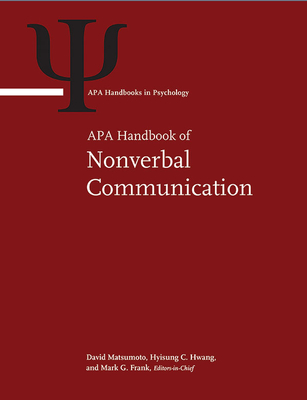
APA Handbook of Nonverbal Communication
Description
The APA Handbook of Nonverbal Communication provides scholarly reviews of state-of-the-art knowledge in the areas of nonverbal communication and nonverbal behaviors. It includes an entire section devoted to new and improved methodologies and technologies that allow for the recording, capture, and analysis of nonverbal behaviors. The primary audience for the book is researchers in the area, as well as by students in graduate-level classes on nonverbal communication or behavior.
The handbook is organized around four broad themes, each of which led to a different section in this volume:
The first concerns the history of the field and includes two chapters providing an overview and history of the area, all written by senior researchers with many years of experience.
The second concerns the factors of influence of nonverbal communication and encompasses the main theoretical and conceptual frameworks within which research on nonverbal communication occurs.
The third theme presents the separate sources of nonverbal communication and behavior and includes chapters on the physical environment, appearance and physiognomy, olfactics and odor, facial expressions, voice, gesture, eye behavior and gaze, and postures, gait, proxemics, and haptics. This section also includes a chapter on nonverbal communication in nonhuman primates.
Finally, the fourth theme concerns advances in research methodologies, and includes chapters on the methods for measuring and analyzing facial expressions, voice, gesture, eye behavior, olfactics, body movements, and nonverbal sensitivity.
About the Author
David Matsumoto, PhD, is an internationally acclaimed author and psychologist. He received his bachelor's degree from the University of Michigan in 1981 with High Honors in Psychology and Japanese. He subsequently earned his master's degree (1983) and doctoral degree (1986) in psychology from the University of California at Berkeley. He is currently professor of psychology and director of the Culture and Emotion Research Laboratory at San Francisco State University, where he has been since 1989. He is also director of Humintell, LLC, a company that provides research, consultation, and training on nonverbal behavioral analysis and cross-cultural adaptation. Dr. Matsumoto has studied culture, emotion, social interaction, and communication for more than 30 years. His books include well-known titles such as Culture and Psychology, the Cambridge Dictionary of Psychology, and Cross-Cultural Research Methods in Psychology. He is the recipient of many awards and honors in the field of psychology, including being named a G. Stanley Hall lecturer by APA. He is the series editor for the Cambridge University Press series on Culture and Psychology and former editor-in-chief for the Journal of Cross-Cultural Psychology. Hyisung C. Hwang, PhD, is an adjunct professor at San Francisco State University. Her research interests are emotion, nonverbal behaviors, facial expressions, and deception. She is the author of numerous scientific articles, book chapters, and conference presentations on these topics. She is also coeditor of Nonverbal Communication: Science and Applications. Mark G. Frank, PhD, is a professor and director of the Communication Science Center at the University at Buffalo, State University of New York, and he is also the sole proprietor of Mark G. Frank, LLC. Dr. Frank received his doctoral degree in social psychology from Cornell University in 1989. Afterward, he received a National Research Service Award from the National Institute of Mental Health to do postdoctoral research with Dr. Paul Ekman in the Psychiatry Department at the University of California at San Francisco Medical School. In 1992, he joined the School of Psychology at the University of New South Wales in Sydney, Australia, where he worked for 4 years until he joined the Communication Department at Rutgers University in New Jersey. In 2005, he accepted a position in his hometown at the School of Informatics at the University of Buffalo, where he created and directs the Communication Science Center. He has published numerous research articles on facial expressions, emotion, interpersonal deception, and also violence in extremist groups. He has had research funding from the National Science Foundation, the U.S. Department of Homeland Security, and the U.S. Department of Defense to examine deception, aggression, and hidden emotion behaviors in checkpoint, law enforcement, and counterterrorism situations. He is also the codeveloper of a patented automated computer system to read facial expressions, for which he won a Visionary Innovator Award from the University at Buffalo. Dr. Frank has used these findings to lecture, consult with, and train virtually all U.S. federal law enforcement/intelligence agencies as well as local/state and select foreign agencies such as Canadian Security Intelligence Service, the Australian Federal Police, and Scotland Yard (United Kingdom). He is also one of the original members and senior fellow of the Federal Bureau of Investigation's Terrorism Research and Analysis Project. He has presented briefings on deception and counterterrorism to the U.S. Congress as well as the National Academies of Sciences. He has also given workshops to the U.S. Federal Judiciary, various state courts, and foreign judges and magistrates.




























